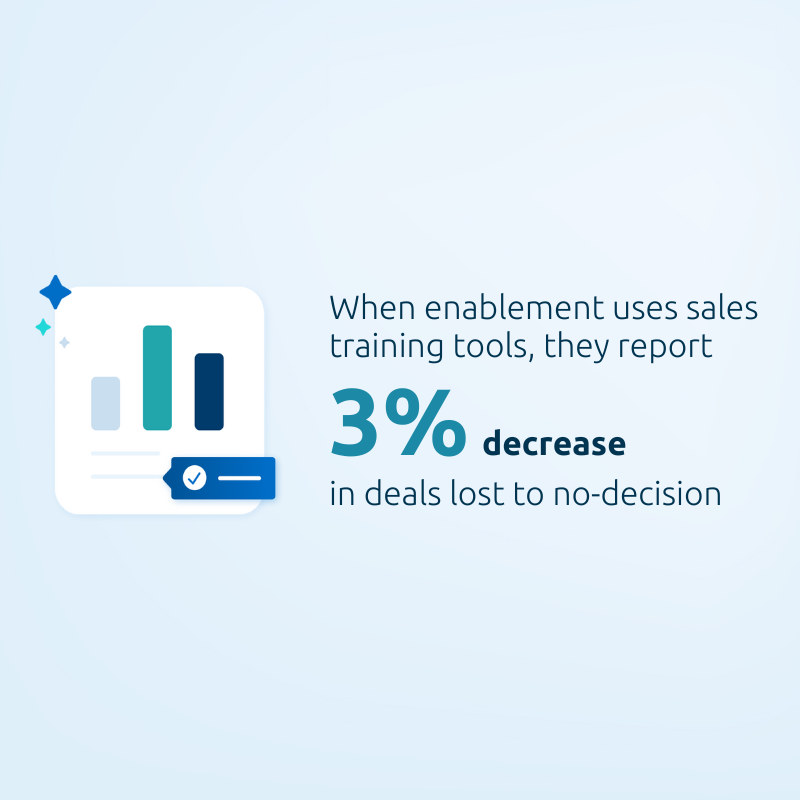Effective training programs can help fast-track reps to productivity.
By demonstrating the organization’s investment in the seller, training allows companies to prepare for changes in the market, which can yield higher job satisfaction, lower turnover, and higher productivity. Enablement can be a powerful force in operationalizing training to drive rigor and consistency, helping companies get the most out of their training efforts. In fact, when enablement leads sales training efforts, organizations are 10% more likely to have high rep engagement.
Read below to learn training techniques that enablement can leverage to accelerate productivity.
Partner With Sales Leaders to Define Goals
Though enablement is a crucial force in building training that continuously improves productivity, practitioners can’t do it alone. It’s important to secure support from sales leaders and sales managers to build learning programs that drive impact.
“A successful ecosystem requires a symbiotic relationship between sales leaders and enablement,” said Gerry Hurley, senior director of sales enablement at Tripadvisor. “You’ve got sales leaders and managers that are held accountable for those specific activities that drive revenue, and sales enablement is accountable to develop the skills to create a spike in activity.”
Sales leaders tend to think about outputs that signify productivity, such as revenue. On the other hand, sales enablement is often concerned with what inputs have to occur to increase productivity. While the particular focus of each party is different, the end goal of achieving a tangible business outcome should be the same. As such, it is essential in the development of any training program to identify what that shared priority is so that practitioners can connect the dots for leaders between the program’s objective and the business outcome it influenced.
“It takes a strategic village,” said Jessica Hoffman, sales enablement manager at AlertMedia. “There are always ways to improve, and it’s our job in enablement to identify that, work with leadership, and work with our reps, new and seasoned, to deliver the most effective programs.”
If reps can understand training goals, they have a higher likelihood of reaching them. Aligning enablement and sales leadership can help clarify expectations for sellers and increase sales effectiveness. Clear, streamlined training processes can help sellers reach their productivity goals faster.
Leverage Data to Drive Accountability
By clearly connecting training to business priorities, enablement can not only engage sales leaders as champions of enablement programs but also drive accountability from reps.
To start, set seller expectations early on in the training process so that every stakeholder involved knows what the target outcomes are. Enablement practitioners can make this effort easier for reps by outlining what training success looks like.
“You have to give [reps] a clear roadmap and expectations,” said Hoffman. “What kind of skills, behaviors, industry knowledge, and tools are they expected to understand and achieve?”
Create accountability for reps and precisely define outcomes by setting KPIs and measuring rep performance against them. For example, measuring productivity-related metrics such as average sales cycle, velocity rate, and lead conversion rate before and after training can help illustrate each seller’s progress.
Optimize Sales Training Tools to Streamline Learning
Learning never ends for a salesperson, so it’s important that enablement continues to evolve training to fit sellers’ changing needs. For enablement practitioners, this can mean periodically evaluating the training tech stack (or implementing one) for effectiveness and relevance. Training tools are becoming increasingly more essential: when enablement uses tools alongside training programs, they report a 3% decrease in deals lost to no-decision.
“Embrace technology,” said Hurley. “Utilize the vast array of amazing tools that are out there to help you fast-track adoption and drive accountability.”
Using a variety of training tools can help reps stay engaged with different learning structures. For example, consider starting with a full-service training course, implementing a micro-learning platform, or bringing in a sales training consultant.
However, too many tools can cause confusion and inefficiency. When implementing a new training tool, have an adoption plan in place to ensure that reps have dedicated time to explore the tool and understand its features and benefits. Enablement can also get feedback from sellers and iterate to closely fit reps’ training needs. If one or more tools are not being effectively utilized or aren’t a good fit, consider reducing the training tech stack to streamline learning processes.
Use Multiple Training Formats to Engage Reps
Training in multiple contexts can drive engagement and help reps apply their learning to their everyday selling activities. The 70-20-10 learning model suggests that people learn from different types of experience: 70% of learning typically results from sharpening skills on the job, 20% is through coaching and peer-to-peer learning, and 10% is from formal coursework and training sessions.
Enablement teams can use the 70-20-10 model to design learning experiences that span beyond traditional classroom sessions. To help sellers learn on the job, where the majority of learning usually comes from, establish multiple training touchpoints in sellers’ daily workflows. For example, create quick micro-learning lessons to quickly reinforce skills and serve them up to reps within the tools they leverage daily. Gamification can also help reps build habits around applying knowledge and skills gained in training.
“Sellers compete, some of them for the prize, but many of them for fame. They want to have their names on the top of the leaderboard, and many of them are just driven by that kind of mentality,” said Mary Tafuri, vice president of global GTM enablement at Pegasystems. “We want them to embrace the journey of gamification to help the rest of the community.”
Enablement can also provide resources for sellers to practice and share best practices with each other. Salespeople can learn productivity-boosting strategies quickly from others on the ground with them who have achieved success in real-world selling situations. Consider creating opportunities, such as digital communication channels or live lunch-and-learn sessions, for reps to share best practices, win stories, competitive insight, common customer objections, and other tips. This can help motivate participation and boost knowledge retention by exposing reps to concepts in multiple contexts and from different perspectives.
“Give sellers an opportunity to socialize and discuss the practices they’re learning in one-on-one coaching calls, in team meetings, in a variety of different ways for them to socialize what they’re learning,” said John Dougan, senior director of global sales performance at Workday.
With clear, outcomes-based training that is engaging, enablement can help reps be more productive, satisfied, and successful. By working with sales leadership to align on responsibilities and target metrics, enablement can create learning programs that are relevant and drive organizational impact. When sellers have opportunities to develop, everyone in the sales organization can benefit.








